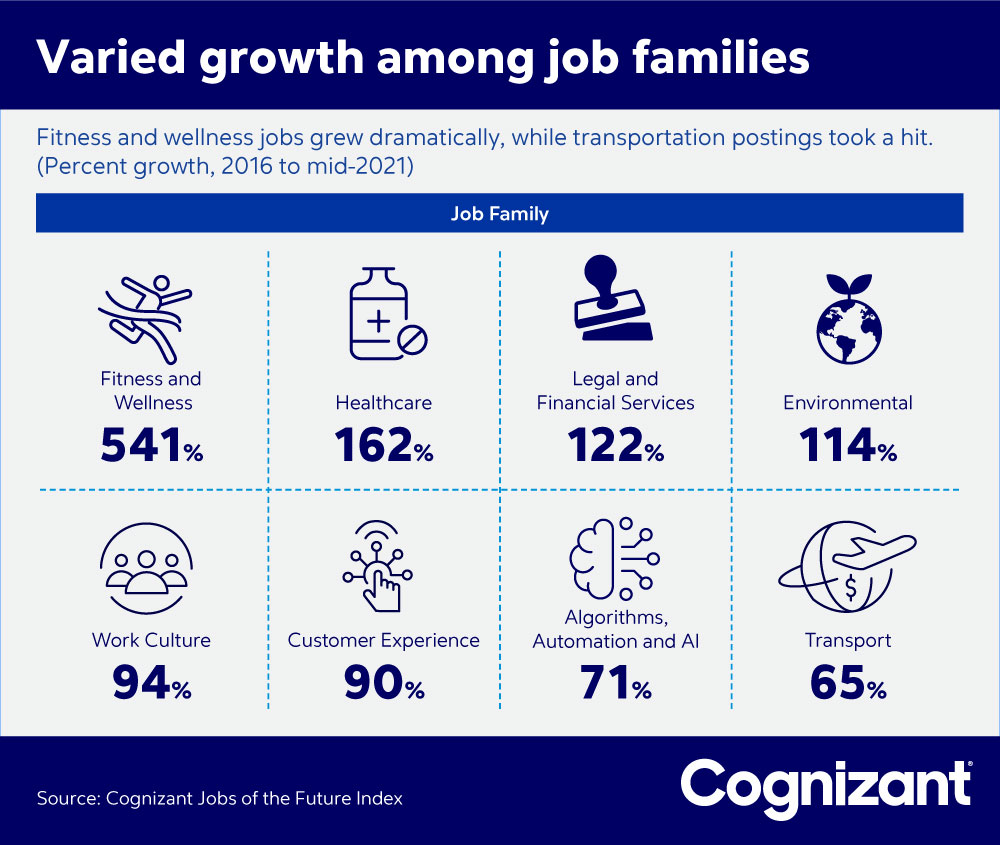March 16, 2022
Then and now: How jobs changed, pre- and post-pandemic
Traditional jobs have grown more quickly than digital-economy jobs in the pandemic’s aftermath, according to our Cognizant Jobs of the Future Index, but other trends point to what the future of work will look like.
Much has changed since Cognizant launched the Jobs of the Future (CJoF) Index in 2018, which tracks job postings for 50 digitally enabled jobs of the future identified by Cognizant’s Center for the Future of Work. In workplaces across the US, use of the latest digital technologies and solutions has transformed employee behaviors, augmented traditional ways of working and led to the creation of new jobs to drive digital growth.
These changes were particularly acute in early 2020 when the COVID-19 pandemic further disrupted not just how and where people worked but also how they lived and obtained goods and services. With businesses lurching into a digital-first world and facing a new industrial era, employee and consumer behaviors further shifted, and new job descriptions emerged.
But the pandemic also changed the trajectory of work, as measured by the CJoF Index. In April 2020, the jobless rate ballooned to 14.8%, marking the end of the longest employment recovery and expansion in US history. With state and local government restrictions on businesses and individuals continuing throughout the year, total non-farm employment ended the year 10 million below its February peak.
The results are evident when you compare the CJoF Index to the All Burning Glass Jobs (ABGJ) Index, which tracks jobs in the overall US economy. From mid-2016 (the start of the period covered by our CJoF data analysis), through to mid-2021, the index grew by 78%, underscoring the vitality of these 50 jobs of the future. Over this same period, the ABGJ Index grew even faster, by 104%.
But when you tighten the focus to mid-2016 to just mid-2020, the CJoF Index outperformed the ABGJ Index (growing by 46% vs. 30%, respectively, from the start of the measurement period). It was after the third quarter of 2020 that the ABGI began outperforming the CJoF Index.
Traditional jobs make a comeback
Here’s why this occurred. After the employment collapse in 2020, the demand for jobs reversed course, and the unemployment rate fell, plunging to 4.2% by November 2021. With restrictions easing and vaccines proliferating — and some workers leaving the labor market for good — there was pent-up demand for traditional service-oriented and brick-and-mortar jobs across sectors that had cut back their activities, including leisure and hospitality, retail, transportation, healthcare, manufacturing and construction.
This is the dynamic that caused the ABGJ Index, which measures all jobs, to outpace the CJoF Index, which measures new digital economy jobs.
At the same time, however, traditional work has been augmented by digital technology, digitized workflows and collaborative tools to enable hybrid working and greater flexibility. Doctors and nurses, for example, now use videoconferencing platforms to see patients, while manufacturing teams collaborate through virtual platforms for remote operations. Virtual lunches replaced the water cooler, and the future of work veered away from new job creation to worker augmentation.
Which jobs grew most
In addition to total job openings, the CJoF Index also monitors trends in eight job families: Algorithms, Automation and AI (AAA); Customer Experience; Environment; Fitness and Wellness; Healthcare; Legal and Financial Services; Transport; and Work Culture. All eight job families posted growth from mid-2016 to mid-2021, but with wide variations heightened by the pandemic.
- Fitness and Wellness was the best-performing family of digitally enabled jobs. It was already expanding quickly before the pandemic, fueled by growing demand for fitness coaches, personal trainers and caregivers, many of whom incorporate wearable technology, embedded sensors, smartphone apps and other technology into their work. Generational shifts also played a part: Millennials were drawn to remote healthcare, and more mobile Baby Boomers sought alternatives to traditional senior care.
The need for these skills spiked further during the health crisis. Demand for caregiver and personal care aides skyrocketed by 1,500% — making it the fastest-growing job category not just in the Fitness and Wellness group but also in the entire CJoF Index. Posts for home health aides also leaped by 600%.
- Healthcare also grew much faster than other job families, particularly core positions like physicians (+386%) and nurses (+188%). This is no surprise, as healthcare workers overall experienced overwhelming demand for their services.
Registered nurses were already in short supply before COVID-19. But the stress of working on the frontlines widened the gap, as many nurses resigned or retired. The shift to telemedicine during the pandemic heightened the need for tech-savvy healthcare workers. Meanwhile, more rarefied healthcare positions of the future saw little growth, such as genetic counselor (+6%).
- Legal and Financial Services performed well, with large increases for general attorneys (+238%) and risk managers (+97%) as the pandemic raised business risks, financial challenges and legal concerns across all industries. The legal and financial industries were able to transition quickly to remote working, which enabled them to ramp up to meet customer needs.
With many jobs within the professional and financial services fields now location-agnostic, demand for such digitally enabled jobs is growing more strongly.
- The Environmental sector performed relatively well, in response to the sharpened expectations of customers, investors and employees regarding sustainability, diversity and social equity concerns. As corporate leaders put more emphasis on environmental, social and governance (ESG) goals, postings for sustainability specialists rose by more than 600%, while those for alternative energy managers jumped by 572%. These jobs will likely continue to grow as sustainability becomes a boardroom priority.
- Work Culture jobs also grew over the period, albeit more slowly overall, as businesses shifted their focus from employee development to safety. Concerns about worker well-being caused postings for industrial/organizational psychologists to jump by 294% and those for career counselors by 234%. By contrast, demand for training specialists was more tepid, with growth of 81%.
- Customer Experience postings initially fell but then rebounded as the pandemic accelerated e-commerce and digital interaction with customers. The rise in customer experience positions grew as businesses geared up for their digital-first future.
Growth was greatest for social media specialists (+241%), and user experience designer demand (+94%) also rose. Sales manager openings grew a bit faster (+98%), while postings for sales engineers, a more esoteric position focused on selling technical services, increased only 20%, dragging down the overall performance of this job family.
Algorithms, Automation and AI was one of the strongest performers until the pandemic struck. Then it fell hard, as businesses went into survival mode. Postings for mobile applications developers, for example, had risen 76% over the three years before the pandemic, but by the fourth quarter of 2020, those gains were largely wiped out.
Yet demand has recently bounced back, and growth for this family since mid-2016 through mid-2021 stoot at 45%. The fastest growth was recorded by mechatronics engineers (+268%), which bridge mechanical and computer engineering, and data scientists (+240%), a central position in today’s data-driven world.
- Transportation jobs took a wallop due to social distancing and the shift to remote working —and the sector will likely undergo further disruption as many of the changes in workers’ behaviors become permanent. Growth in aviation and avionic job postings, for example, slowed notably (averaging around 50%) as global tourism slumped.
However, demand for urban transportation planners was firmer (+126% in postings) as cities moved to align local mobility with evolving patterns of travel and work.
From a job-by-job standpoint, the fastest-growing jobs in the CJoF Index from mid-2016 to mid-2021 reflect these broader trends and share a common trait: they focus on the health and safety of people and the planet.
- Caregiver/Personal Care Aide (+1,505%)
- Sustainability Specialist (+607%)
- Home Health Aide (+603%)
- Alternative Energy Manager (+572%)
- Physician (+386%)
Conversely, the slowest growing jobs in the CJoF Index over the same period were generally jobs of the future whose expansion was diminished by the pandemic.
- Genetic Counselor (+6%)
- Biomedical engineer (+11%)
- Sales Engineer (+20%)
- Personal Financial Advisor (+23%)
- Solar Installer (+33%)
Where we go from here
The uptick in openings for digitally enabled jobs in the first half of 2021 bodes well for the jobs of the future. It broadly suggests a continued transition to a digital-first world, better prospects for skilled, higher-wage earners, and larger investments by private businesses and the public sector in their own digital transformation.
But the CJoF Index also suggests the emergence of other trends that will shape our work lives in the coming years. One is greater emphasis on ESG issues, which will have major implications for how, why and where people choose to work. Another is the shift to hybrid working, which will likely continue even after the pandemic ends. With these trends converging, the future of work is coming into greater focus.
To learn more, visit the Travel & Hospitality section of our website or contact us.
We’re here to offer you practical and unique solutions to today’s most pressing technology challenges. Across industries and markets, get inspired today for success tomorrow.
Latest Posts
Related topics
Subscribe for more and stay relevant
The Modern Business newsletter delivers monthly insights to help your business adapt, evolve, and respond—as if on intuition




